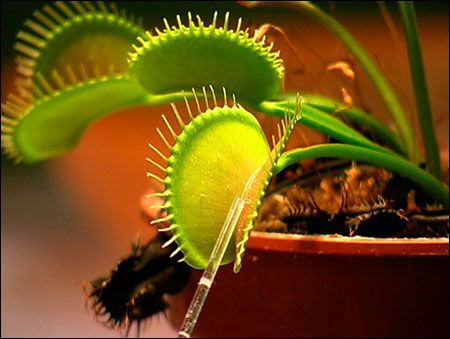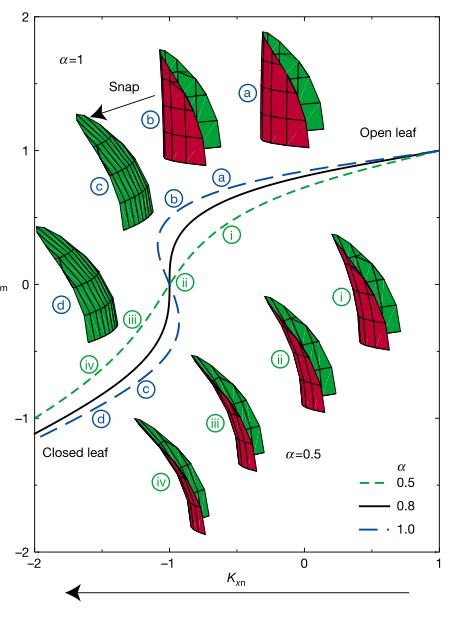tags: Venus flytrap, plant, biology, mechanics
A Venus flytrap lies open, waiting for an insect to set off its trap. Lakshminarayanan Mahadevan and colleagues have shown that the plant uses stored elastic energy to operate its hinged leaves.
Image: Yoel Forterre.
How does the venus flytrap accomplish what most people cannot? How does a mere plant capture live flies? The mystery of the Venus flytrap's rapid movement lies in storing and releasing elastic energy, says Lakshminarayanan Mahadevan, who is the Gordon McKay Professor of Applied Mathematics and Mechanics at Harvard University.
Mahadevan compared the Venus flytrap's hinged leaves to a plastic lid that is bowed out in one direction before it then suddenly pops the other way. Basically, the plant's leaves are bowed outward, which opens the hinged trap while the plant awaits prey. When an insect touches a trigger hair inside the trap, the plant rapidly moves water around in its leaves, thereby changing their curvature, suddenly snapping them shut.
Smooth-snapping transition in Venus flytrap leaf closure. Here, the researchers plotted the dimensionless average curvature Km=(Kx+Ky)/2 as a function of the control parameter, Kxn.
Basically, the leaf undergoes three stages of closure beginning with a (a) brief initial phase where it moves slowly, followed by a (b to c) rapid "snapping" transition, followed by a (d) slow closing phase. Red denotes the inner surface of the leaf and green denotes the outer side of the leaf.
"It is a relatively simple mechanism, but the plant is actively controlling it," Mahadevan said.
The research was inspired by the gift of a Venus flytrap to Mahadevan from one of the members of his research lab. Mahadevan and his colleagues, Yoel Forterre, currently of the Universite de Provence and Jacques Dumais, now an assistant professor of organismic and evolutionary biology at Harvard, were intrigued enough by the rapid movement of the closing traps to learn more about it.
"We studied this because it is an extreme event. The very fact that it is a plant and it is moving fast was enough for us to want to study it," Mahadevan said.
To see how the flytrap works, they painted ultraviolet fluorescent dots on the leaves and then filmed them under ultraviolet light using high-speed video. By breaking down the movements, they were able to reconstruct the geometry of the leaf and design a mathematical model to help them understand the mechanics that cause the trap to snap closed.
Unfortunately, gaining a little understanding of the mechanics for the flytrap movement does not reveal anything about the molecular biology that underlies this event. Even though this unusual plant would seem to generate a great deal of research, it remains poorly understood.
"Familiarity does not immediately mean comprehension," Mahadevan observed.
Sources
How the Venus flytrap snaps, by Yoel Forterre, Jaques Dumais & L. Mahadevan. Nature 433:421-425 (27 January 2005).



That's 2005, not 2007. No matter what the year, a very cool study.